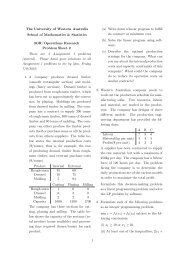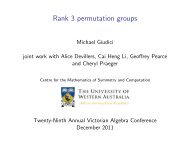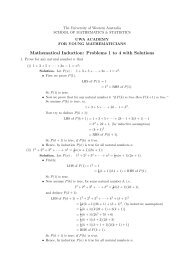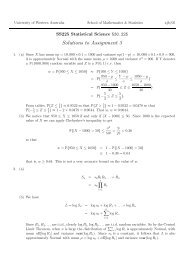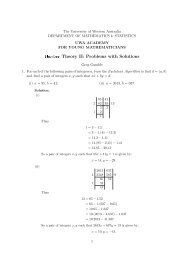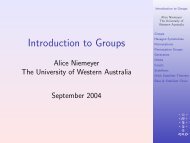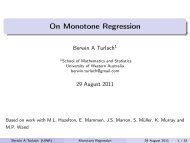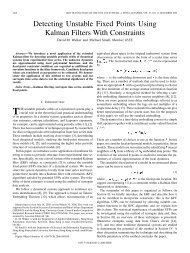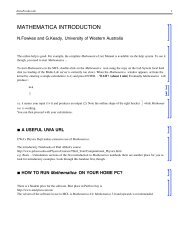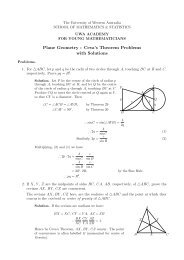Ceva's Theorem with Problems - The University of Western Australia
Ceva's Theorem with Problems - The University of Western Australia
Ceva's Theorem with Problems - The University of Western Australia
Create successful ePaper yourself
Turn your PDF publications into a flip-book with our unique Google optimized e-Paper software.
A<br />
8. Let AX be a cevian <strong>of</strong> △ABC <strong>of</strong> length p dividing BC<br />
into segments BX = m and XC = n. Prove<br />
a(p 2 + mn) = b 2 m + c 2 n.<br />
c<br />
p<br />
b<br />
This result is known as Stewart’s <strong><strong>The</strong>orem</strong>.<br />
Hint. Use the Cosine Rule on each <strong>of</strong> △ABX and B m X n C<br />
△AXC, in each case taking the cosine <strong>of</strong> the angle at X. What relationship do the cosines<br />
<strong>of</strong> supplementary angles have?<br />
A<br />
9. Prove that the medians <strong>of</strong> a triangle dissect the triangle<br />
into six smaller triangles <strong>of</strong> equal area.<br />
Hint. Suppose in the diagram that x, y, z represent the<br />
z y<br />
Z Y<br />
areas <strong>of</strong> the smaller triangles they lie in. Show the two<br />
triangles marked x have the same area, by showing they z G<br />
y<br />
have a common altitude, and similarly for y and z. <strong>The</strong>n<br />
x x<br />
in a similar way show 2x + z = 2y + z. Continue from B X C<br />
there.<br />
10. Prove the medians <strong>of</strong> a triangle divide each other in the ratio 2 : 1, i.e. the medians <strong>of</strong> a<br />
triangle trisect one another.<br />
11. Prove that each (internal) angle bisector <strong>of</strong> a triangle<br />
A<br />
α α<br />
divides the opposite side into segments proportional in<br />
length to the adjacent sides, e.g. if AX is the cevian c<br />
b<br />
<strong>of</strong> △ABC that bisects the angle at A internally, then<br />
BX : XC = c : b.<br />
Hint. Use the Sine Rule on each <strong>of</strong> △ABX and △AXC,<br />
in each case taking the sine <strong>of</strong> the angle at X.<br />
B X<br />
C<br />
What relationship do the sines <strong>of</strong> supplementary angles have?<br />
12. <strong>The</strong> angle bisector <strong>of</strong> the angle between two sides is the locus <strong>of</strong> points that are equidistant<br />
from the sides making the angle. One consequence <strong>of</strong> this is that any pair <strong>of</strong> internal angle<br />
bisectors <strong>of</strong> a triangle meet at a point that is equidistant from all three sides <strong>of</strong> the triangle,<br />
and hence in fact the three internal angle bisectors are concurrent.<br />
<strong>The</strong> point at which the angle bisectors <strong>of</strong> a triangle concur is the incentre I, the common<br />
(perpendicular) distance from I to the three sides is the inradius r, and the circle <strong>with</strong><br />
centre I and radius r thus touches each side tangentially and is called the incircle <strong>of</strong> the<br />
triangle.<br />
Find an alternative pro<strong>of</strong> that the (internal) angle bisectors <strong>of</strong> a triangle concur, using<br />
Ceva’s <strong><strong>The</strong>orem</strong> and the result <strong>of</strong> the previous problem.<br />
2



